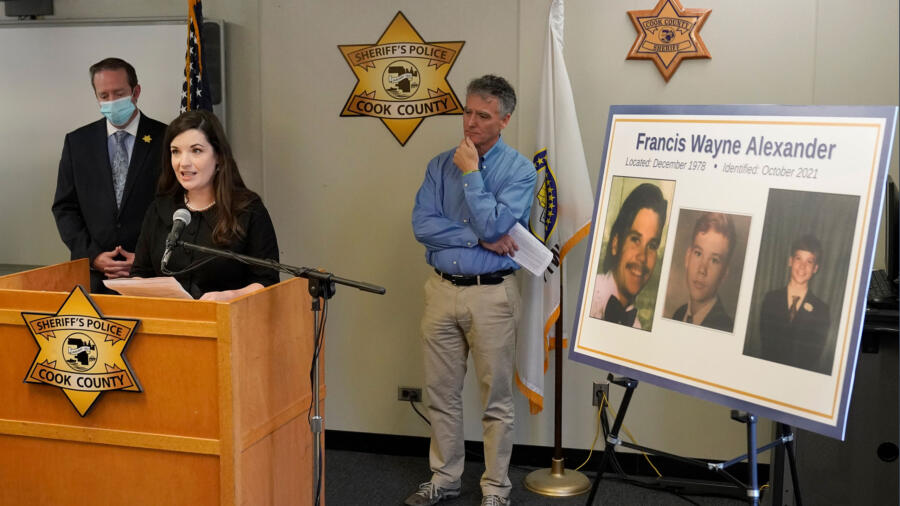For over 40 years, Victim No. 5 lay in a morgue, his name unknown, lost in the shadow of serial killer John Wayne Gacy. That all changed in October 2021, when investigative genetic genealogy gave him back his identity:
Francis Wayne Alexander.
This extraordinary breakthrough was made possible by the DNA Doe Project, a nonprofit that uses advanced DNA science to solve cold cases and identify unknown remains. Their secret weapon? A single molar, a network of volunteers, and a powerful blend of forensics and family trees.
From Serial Killer Horror to Scientific Hope
Between 1972 and 1978, John Wayne Gacy tortured and murdered at least 33 young men. He buried 26 of them in the crawl space beneath his Illinois home. Many were identified quickly—but eight remained nameless for decades.
One of them was Victim No. 5.
Despite extensive efforts, police couldn’t link the remains to any missing person. That is, until investigative genetic genealogy entered the scene.
The DNA Doe Project: Turning Teeth into Truth
Founded by Margaret Press and Dr. Colleen Fitzpatrick, the DNA Doe Project was born from a simple but powerful idea:
Could the same DNA tools used to reunite adoptees with birth families identify the nameless dead?
Starting with nothing more than skeletal remains, volunteers extract viable DNA—often from teeth, the most resilient source. The DNA is sequenced, cleaned up by a bioinformatics expert, and uploaded to GEDMatch, a public database used by genealogists.
From there, volunteers spend weeks or months building out family trees, using distant cousin matches to zero in on a potential identity.
In Victim No. 5’s case, a cavity-free molar preserved enough DNA to make the miracle happen.
Francis Wayne Alexander: The Man Behind the Number
Born in North Carolina, Francis Wayne Alexander moved to Chicago in the mid-1970s in search of work. Somewhere along the way, he crossed paths with Gacy. After his disappearance, his family assumed he had simply distanced himself.
“They thought he just wanted nothing more to do with them,” said investigators. “They never imagined he was one of Gacy’s victims.”
Through genetic genealogy, his second cousin was identified in the database. Once the connection was verified, law enforcement delivered the news—privately, respectfully, and before the media storm hit.
The Cost of Solving a Cold Case
While volunteers drive the effort, the technology isn’t free:
- DNA extraction and sequencing from teeth or bone: $4,000
- GEDMatch access fee for law enforcement: $1,000
- Total per case: up to $5,000, often crowdfunded or covered by donations
Despite limited resources, the DNA Doe Project doesn’t turn away cases. If law enforcement runs out of money, they find a way to fund it—because for them, a name is priceless.
Ethics, Equity, and the Future of Genetic Sleuthing
Not everyone supports the rise of forensic genealogy. Privacy concerns remain, and many DNA testing companies refuse to share data with law enforcement. As a result, databases like GEDMatch remain small—about 1.4 million profiles, compared to 20+ million in commercial sites.
In addition, racial and cultural representation is uneven. Due to distrust and affordability issues, communities of color are underrepresented, creating challenges in identification.
“We can only solve what’s in the database,” says Press. “More diversity means more solved cases.”
More Than Science: This Is Humanity’s Work
Margaret Press never set out to be a forensic hero. She was a software developer and mystery writer. But a fascination with genealogy, a neighbor’s murder, and a love for uncovering truth transformed her life—and the lives of hundreds of families.
“We’re not just finding names,” she says. “We’re giving people their loved ones back.”
Why This Case Mattered More Than Most
The identification of Francis Wayne Alexander was about more than closure. It was about correcting history, respecting the dead, and holding even the most infamous monsters—like Gacy—fully accountable for their victims.
His name had been lost for over 40 years. But thanks to a single tooth, a team of passionate volunteers, and some cutting-edge science, he was finally brought home.
🧠 Frequently Asked Questions
What is investigative genetic genealogy?
It combines DNA analysis with genealogical research to identify unknown individuals, often in criminal or cold cases.
Who was Victim No. 5 in the John Wayne Gacy case?
He was Francis Wayne Alexander, identified in 2021 using investigative genetic genealogy.
What is the DNA Doe Project?
A nonprofit that uses advanced DNA techniques and family tree building to identify John and Jane Does.
How long did it take to identify Francis Alexander?
Once DNA was sequenced and matched to relatives, it took approximately 60 days of research to confirm his identity.
Is it expensive to solve cases like this?
Yes. Costs can range from $3,000–$5,000 per case, depending on the condition of remains and lab fees.
Are there any privacy concerns?
Yes. Some genealogy companies decline law enforcement access due to privacy policies, limiting the database size and reach.

